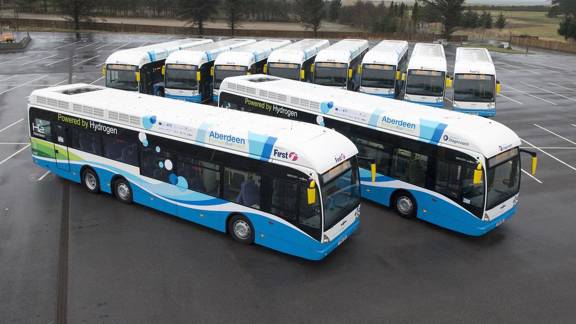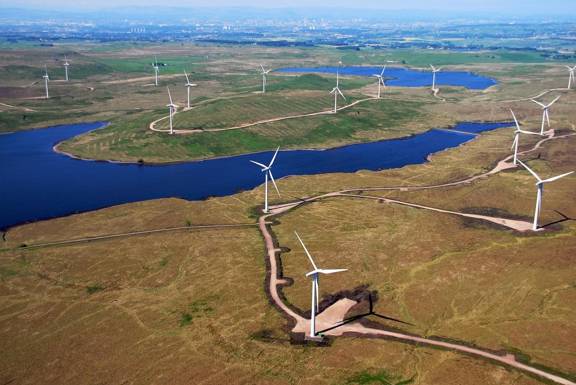Hydrogen: how it's decarbonising heavy duty transport
24 Jul 2023 • 7 minute read
Learn how Scotland's public and private sectors are collaborating to find ways to make hydrogen fuel more widely accessible.

Decarbonising heavy duty transport is one of the biggest hurdles in the race to net zero. In Scotland, hydrogen is being used and developed as a clean fuel in buses, freight trucks and trains. Learn how the country is becoming a leader in the clean energy transition.
Scotland's hydrogen vehicles
The need for cleaner, more resilient, fuels has never been greater. With its potential for domestic production, hydrogen offers many advantages.
In Scotland, hydrogen is already powering zero-emission vehicles from stations in Aberdeen which have served over 80 buses, cars, and heavy-duty vehicles (HGVs) since 2015. And on the Bo’ness and Kinneil Railway in the central lowlands, a retrofitted train has also been running on hydrogen.
Within the next decade, Transport Scotland predicts that hydrogen-powered HGVs will be widely used on Scottish roads. While battery-electric is considered the best option for smaller vehicles, the potential of fuel cell technology is being embraced for heavy-duty transport and could be adopted on a similar scale to diesel.
In terms of cost, the surge in global fuel prices has brought the gap between diesel and hydrogen closer together. In fact, hydrogen vehicles can deliver a comparable operational range and load capacity to diesel engines. However, transitioning vehicles from fossil fuels requires changes to existing systems and infrastructure.
Transitioning to low carbon transport
Fiona Landy is a Hydrogen Accelerator Project Manager at University of St Andrews. She's heavily involved with a project that brings together five local authorities from across Scotland to evaluate clean energy requirements. Working alongside the Energy Savings Trust, data is analysed to build a clear picture of how many fuel cell electric vehicles (EVs) are required in the operation fleet for each area.
“Building up the model for funding these vehicles, as well as the timelines, all helps Transport Scotland understand what their budgetary requirements will be going forward,” adds Landy.
People often assume that it’s expensive to develop and use clean energy technologies. However, Landy’s team spends a lot of time overcoming perceptions that hydrogen is too costly or unreliable.
Building refuelling infrastructure
For hydrogen to be adopted as a commercial transport fuel, refuelling stations need to be widely available. The Hydrogen Accelerator project trials refuelling models for hydrogen-powered vehicles around Scotland and plans the infrastructure.
“When we get the model right, which we hope to do very shortly, we will start to look at how we replicate that across Scottish regions. That’s our plan. We’ll look at working on this with both the public and private sectors.” adds Landy.
Aberdeen remains a leading location for hydrogen development. Expanding on the two refuelling stations already in use, the city council signed a joint venture agreement with BP earlier in the year. The aim is to develop a hydrogen hub — a production facility and refuelling infrastructure — that can produce enough green hydrogen to power 25 buses a day from 2024.
There’s potential for the hub to scale up to produce green hydrogen for freight, marine, and rail transportation. In this case, there would be an opportunity to export products too.
Green hydrogen production
Whitelee Windfarm near Glasgow is an example of how Scotland is using its vast renewable resources to produce green hydrogen. Some of the energy created here is used to power electrolysers which split water into its chemical elements, hydrogen and oxygen, to produce the zero-emission fuel.
The Whitelee facility will be central in the production of green hydrogen, with ScottishPower storing supplies there. Once fully operational, the facility is projected to have a daily production capacity of eight tonnes of green hydrogen — equivalent to the energy needed to power 550 buses on a return trip from Glasgow to Edinburgh.
The hydrogen will be transported by tankers to smaller refuelling hubs across the region. If progress continues, green hydrogen could be commercially available from Whitelee before the end of 2024.
In the next eight years, Scotland’s ambition is to reach 5GW from hydrogen production through zero-emission or low-carbon methods. By 2045, the target for hydrogen production rises further to 25GW. The country’s chances of reaching the target are high because it owns a significant proportion of European offshore wind resources.
Scotland also has huge potential in tidal energy and is continually developing projects to harness these sources. These factors should encourage original equipment manufacturers to invest in Scotland and pursue developments in green energy as an emerging sector.

Aerial view of Whitelees Windfarm in Eaglesham
Retrofitting transport to run on hydrogen
To transition to a low-carbon economy more quickly and with minimal disruption, adapting existing infrastructure and systems is considered a better option than building everything from scratch. It’s also cheaper and is an opportunity to bring in experts from other industries.
A successful example of a retrofit is the conversion of a 40-year-old train, carried out by the Hydrogen Accelerator team and partners. The ex-ScotRail train has been successfully running on the Bo’ness-Kinneil heritage line, powered by green hydrogen.
According to Landy, normal budgets for such a project would be around £30 million, yet the Hydrogen Accelerator team delivered the project for a fraction of the cost — £3 million. Crucially, the project also used the skills and expertise within Scottish industries such as oil and gas.
Hydrogen-powered trains are expected to be particularly important in the future, particularly in rural areas where the electrification of rail lines is not always cost-effective.
Decarbonising existing fuels
Another promising use of clean hydrogen is to blend the gas with other substances to create low-carbon fuels for use in existing combustion engines.
For example, blending clean hydrogen with captured carbon creates e-methanol — a synthetic replacement for fossil fuels. While there are carbon emissions with these hybrid fuel types, they are significantly lower than existing fossil fuels and require minimal adaptation for heavy-duty engines. There are also benefits for transportation.
In addition, hydrogen can be used to create ammonia for industrial processes and fuels with a substantially lower carbon footprint than current levels. Ammonia is commonly produced by combining nitrogen with grey hydrogen, which is made by steam methane reformation of natural gas — without capturing greenhouse gases, in a process that’s highly polluting.
Replacing grey hydrogen with green or blue hydrogen (made in a similar process to grey hydrogen but with the benefit of capturing the carbon) could decarbonise industrial processes. Heavy industries such as shipping can also use ammonia as fuel.
A hydrogen action plan
The growth of Scotland’s hydrogen economy relies on backing from the Scottish Government through a series of initiatives and long-term investment schemes.
“We have supported initiatives, such as the establishment of the Hydrogen Accelerator at St Andrews University, to further learning and provide advice and support to hydrogen projects across all modes of transport,” says a spokesperson for Transport Scotland.
“We have already seen several successful hydrogen demonstration projects in Scotland, including Aberdeen’s Hydrogen Bus project, and the Zero Emission Train Project – a joint undertaking between the public and private sectors.
“In addition, our £28 million Zero Emission Mobility Innovation Fund aims to accelerate the manufacturing and deployment of heavy-duty zero-emission vehicles, including hydrogen vehicles. It is delivered in partnership with Scottish Enterprise and links to other national funding programmes for manufacturing to support Scotland’s Mission Zero for transport.
“The Scottish Government’s Hydrogen Action Plan will set out how we will build on this success in order to create a thriving hydrogen economy in Scotland.”
Partnerships between industry, businesses and academia are crucial to drive growth in Scotland’s hydrogen economy and position the country as a world leader in this specialist field.
Read the five year Hydrogen Action Plan on scot.gov opens in a new window
Get the latest investment news from Scotland.
Want to talk?
If you want to discuss investment opportunities, our advisors are always ready to help.
